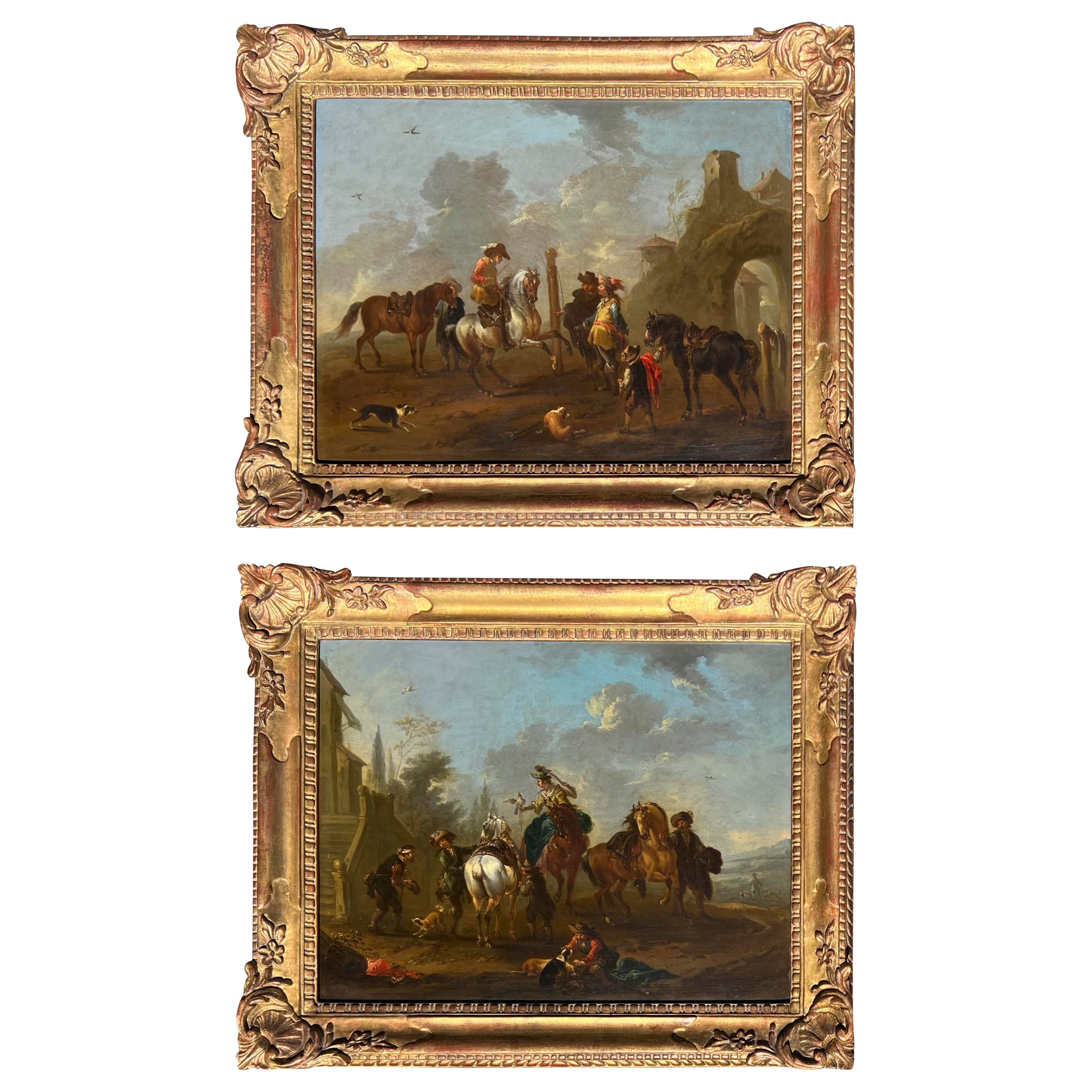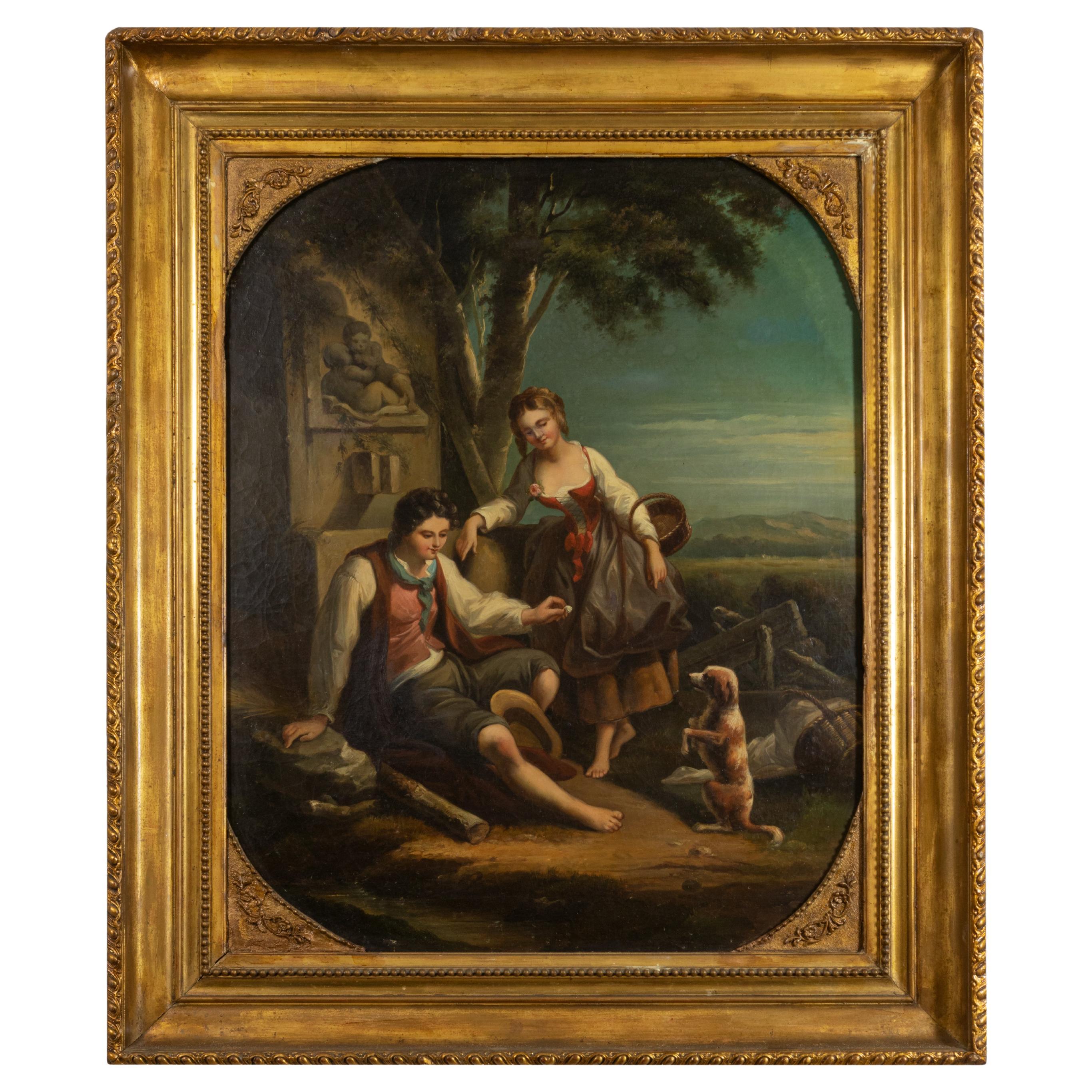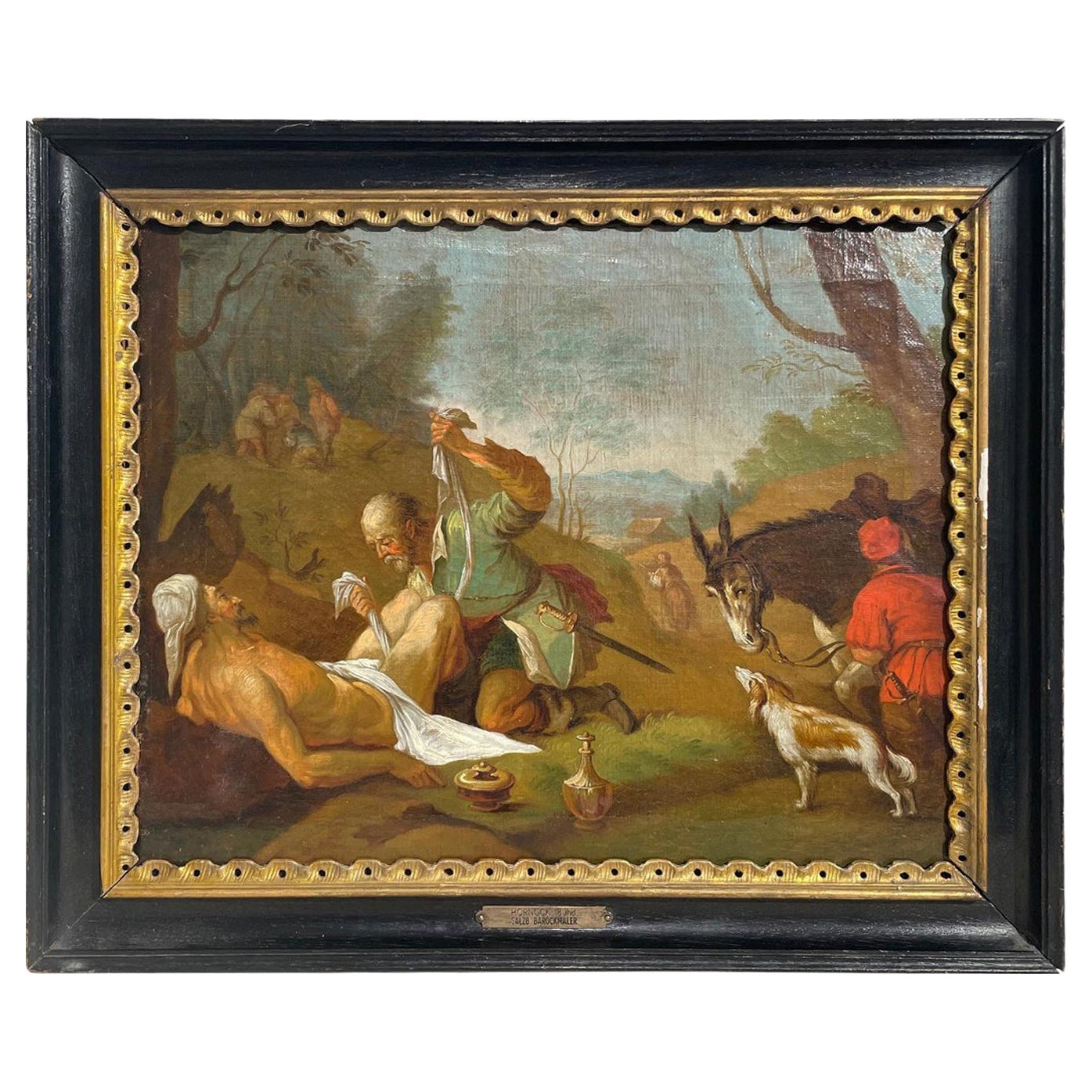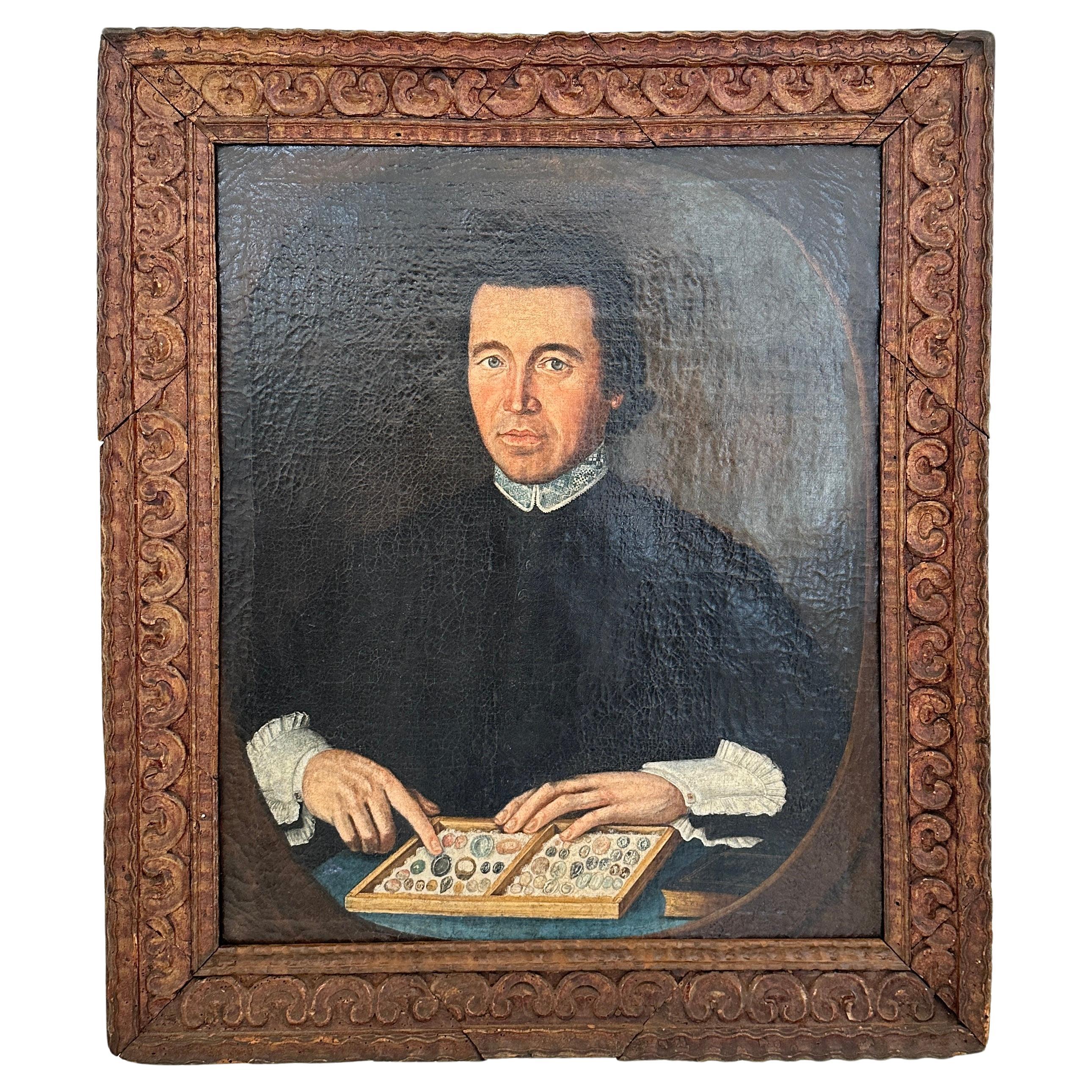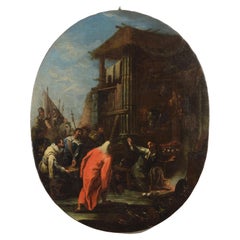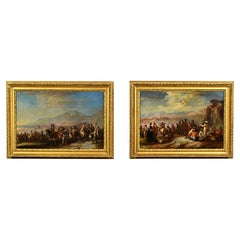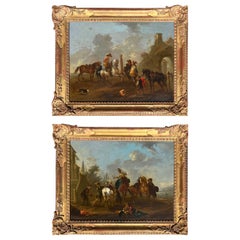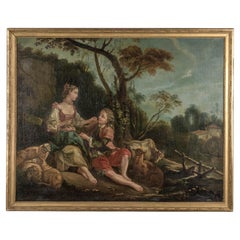Items Similar to 18th Century, Baroque Austran Painting by August Querfurt
Want more images or videos?
Request additional images or videos from the seller
1 of 15
18th Century, Baroque Austran Painting by August Querfurt
About the Item
August Querfurt (1696, Wolfenbüttel - 1761, Vienna)
Farmers and villagers at the entrance of a village
Oil on panel , cm 38,5 x 51. frame 66 x 53,5 x 4,5 cm
The valuable painting, with a great chromatic impact thanks to the technique of oil on board, depicts a lively scene of daily life in the countryside, set near the entrance door of a village. The episode of rural life, depicted with great vitality, through the use of quick touches of color and material, illustrates right, at the gates of the village, a cart loaded with hay and two farmers at work. Next to them sit some figures who stand beside their horses. A woman on her horse reaches a passer-by while behind a shepherd walks with his dog next to him. On the left, a child sits on his back while playing with dogs next to a horse, who is resting while sitting. The entrance to the village is characterized by an arched passage between ancient walls, described with poetic rovinism, as well as some houses. The clear sky is marked by some grey white clouds.
The work is signed with the letters A.Q. at the bottom right, recognizable in the monogram that Georg Kaspar Nagler indicates in his famous volume as belonging to the painter August Querfurt. His description informs us that the "Painter of battles of Wolfenbuttel (Germany), pupil of his father Tobias, painted in the style of Burgundy. In some of his works, which also depict hunting, are the initials of the name. He was stabbed at the hands of J. Burdé and A. Balzer. This master died in Vienna in 1761".
The stylistic comparison with the works signed and traced back by critics to Querfurt’s hand show similarities both in the artist’s characteristic technique, in the colour used and in the choice of subjects.
You can recognize some typical characters of the bambocciate of the master such as the drafting of color, with easy and fast brushstrokes proving to be skilled, through the highlights, in the yield of volumes and depths. The painter carefully describes the different protagonists, their gestures and clothing; attention that indicates a study from the truth of everyday life, read and interpreted with naturalism.
August Querfurt was born in Wolfenbuttel, Vienna in 1696 and is best known for his subjects depicting soldiers and battle scenes, certainly influenced by Philips Wouwerman’s painting.
Educated by his father, Tobias Querfurt, painter of landscapes and animals at the court of Brunswick, he later studied with Georg Philipp Rugendas (Augsburg 1666-1742) in Augsburg.
In 1752, Querfurt became a member of the Academy of Vienna. He had important commissions, as evidenced, among others, the twelve canvases, some large, made for Duke Charles Alexander of Württemberg and the eight paintings commissioned by Empress Maria Theresa depicting war events related to the War of the Austrian Succession (1740-1748). The works for the Empress are now housed in the Museum of Military History located in Vienna. Querfurt lived in a very turbulent period: the Holy Roman Empire, the Ottoman Empire, the Habsburgs, Great Britain and a number of other forces fought several battles near Vienna where Querfurt lived.
In the Austrian capital he died in 1761.
Some of his works are now exhibited at the Belvedere Palace in Vienna, at the National Gallery of Augsburg, others are in Berlin, Dresden, Stuttgart and Bratislava.
[… ]
In conclusion, the discovery of this work together with the recognition of the monogram, allows to add to the corpus of works of August Querturt a valuable testimony of his technical abilities and the confirmation that he was a talented painter of subjects different to the genre of battles to which in the past was exclusively traced.
We apologize for any translation errors. Please contact to have the expertise in Italian.
outlining more clearly the figure of the author.
- Dimensions:Height: 21.26 in (54 cm)Width: 25.99 in (66 cm)Depth: 1.97 in (5 cm)
- Style:Baroque (Of the Period)
- Materials and Techniques:
- Place of Origin:
- Period:
- Date of Manufacture:18th Century
- Condition:
- Seller Location:IT
- Reference Number:1stDibs: LU4405217793742
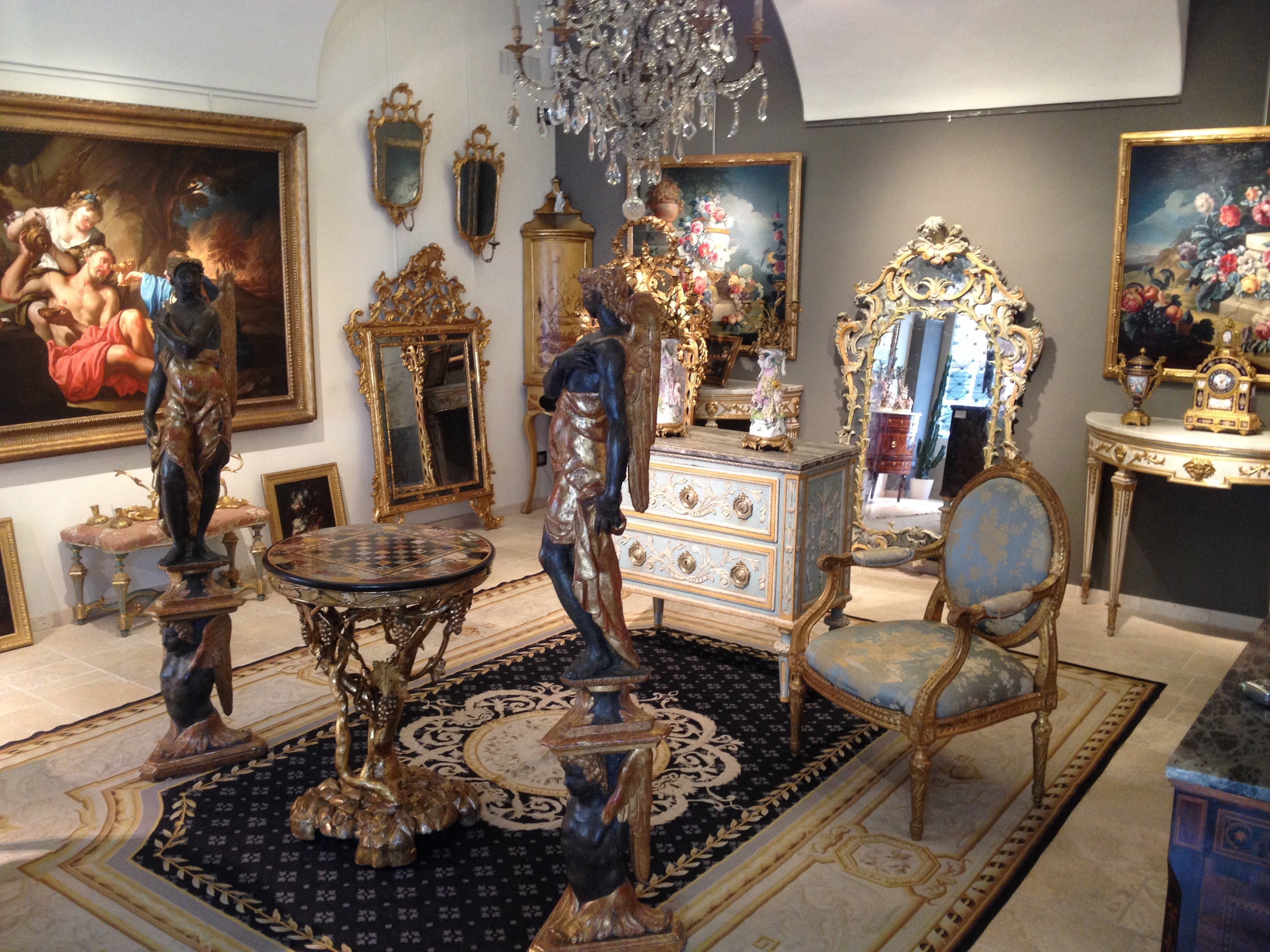
About the Seller
5.0
Platinum Seller
Premium sellers with a 4.7+ rating and 24-hour response times
Established in 1980
1stDibs seller since 2019
53 sales on 1stDibs
Typical response time: <1 hour
- ShippingRetrieving quote...Shipping from: Italy
- Return Policy
Authenticity Guarantee
In the unlikely event there’s an issue with an item’s authenticity, contact us within 1 year for a full refund. DetailsMoney-Back Guarantee
If your item is not as described, is damaged in transit, or does not arrive, contact us within 7 days for a full refund. Details24-Hour Cancellation
You have a 24-hour grace period in which to reconsider your purchase, with no questions asked.Vetted Professional Sellers
Our world-class sellers must adhere to strict standards for service and quality, maintaining the integrity of our listings.Price-Match Guarantee
If you find that a seller listed the same item for a lower price elsewhere, we’ll match it.Trusted Global Delivery
Our best-in-class carrier network provides specialized shipping options worldwide, including custom delivery.More From This Seller
View All18th Century, Painting with Still Life by Maximilian Pfeiler
Located in IT
Maximilian Pfeiler (active Rome, circa 1694-circa 1721 Budapest)
Still life with peaches, grapes, figs and pomegranate
Oil on canvas, Measures: cm H 63,5 x W 47. With frame cm ...
Category
Antique Early 18th Century Italian Baroque Paintings
Materials
Canvas, Wood
$24,144 Sale Price
20% Off
18th Century, Italian painting Depicts Bambocciata by Giovanni Michele Graneri
Located in IT
Giovanni Michele Graneri (Italy, Turin 1708-1762)
Bambocciata (Farmers dancing in front of the inn)
The painting, made in oil on canvas, depicts a moment of celebration where some p...
Category
Antique Mid-18th Century Italian Baroque Paintings
Materials
Canvas
$20,430 Sale Price
32% Off
18th Century, Italian Oval Painting by Pietro D Ollivero with Historical Subject
Located in IT
Painting by Pietro Domenico Ollivero.
"Manio Annio Curio Dentato receives the ambassadors of the Samnites", around 1740
The work in question depicts the scene of and was made by the famous italian painter Pietro Domenico Ollivero. The oval canvas shows on the back the card of the Galleria Caretto in Turin (Italy) with the authentic 1965 Giorgio Caretto. The work was also published in "I Piaceri e le grazie" by Arabella Cifani and Franco Monetti in 1993.
The subject refers to the history of Rome and an episode narrated by the historian Valerio Massimo.
Manius Curius Dentatus (330 BC - 270 BC), one of the great Romans of the 3rd century B.C. was a consul in ancient Rome, known for ending the Samnite Wars. Elected consul in 290 BC. along with Publio Cornelio Rufino, in the same year he fought and won the Third War against the Samnites and their allies, thus ending a conflict that had lasted for 49 years. He definitively subdued the Sabines and the Greek army of Pyrrhus in the battle of Benevento. He represented the ideal prototype of ancient Roman for the generations that followed in that he avoided public honours; Cato the censor, who collected his sayings, placed him among the great figures of universal history. For centuries after his death (in 270 B.C. while overseeing the construction of the second aqueduct in Rome) his military exploits were recounted and his moral rectitude was praised as an example for all the Romans. Ollivero, in the cultured choice of the episode, illustrates the moment when Manio Curio Dentato is found in his home, characterized by Roman walls, sitting by the fire, on a rustic bench while eating his meal in a "ligneo catillo" (wooden basin...
Category
Antique 1740s Italian Baroque Paintings
Materials
Canvas
$13,465 Sale Price
20% Off
18th Century, Italian Pair of Oil on Canvas Paintings by Francesco Simonini
By SIMONINI
Located in IT
Francesco Simonini (Parma, 16 June 1686 - Parma, 1766)
“The rest of the soldiers” and “The march of soldiers”
oil on canvas
cm 40 x 58 and 40 x 60 ; frame: h 52,5 x W 70,5 x D 6 an...
Category
Antique Early 18th Century Italian Baroque Paintings
Materials
Canvas
$27,162 Sale Price
35% Off
18th Century, Pair of Italian Paintings, Landscapes with Ruins by Gaetano Ottani
Located in IT
Gaetano Ottani (1720 - 1724 / 1801)
Pair of paintings depicting landscapes with ruins and figures
Measurements: canvas cm W 82 x H 66; with frames cm W 98 x H 82 x d 6
The two valuable paintings, made in oil on canvas, depict landscapes with architectural whims animated by some figures. The architectural whim, an artistic genre that has made its way in Italian painting since the seventeenth century, is characterized by the representation of fantastic architectures or inventions of perspective type, sometimes combined with elements drawn freely from reality.
In the works we observe large arches, colonnades and friezes fallen into disrepair, placed in perspective in order to create a greater depth, are inhabited by spontaneous vegetation that partly covers the top. Around other architectural elements of classic taste, such as sarcophagi and vases, move and balance the composition. Greenery dyes the ground, which fades on the horizon into plains with some small and distant buildings, while some rocky mountains are lost far away, creating a scenic backdrop that emphasizes and amplifies the effect of the perspective escape line of buildings.
Some figures of gentlemen who entertain in speeches, accompanied by a dog, other travellers and characters from rural life enliven the composition.
It highlights a remarkable pictorial quality with which the artist traces the characters and the ruins and a bright and well-balanced color, played on delicate tones and in harmony with each other.
Stylistically the works are certainly attributable to the Italian painter Gaetano Ottani (Italy, Bologna, 1708 - Turin, 1801).
Gaetano Ottani was born in Bologna in 1708. Unfortunately, the artist still lacks a monographic study. The date of death by many still erroneously indicated in 1808 is instead 14 January 1801 when the artist was 92 years old. He was therefore born in 1708, and not in 1720-24 as many report (for the recording of the act of death to the Municipality of Turin, cf. Historical Archives of the Municipality of Turin, Rubrics of the Acts of Death, vol. 37: Thursday, January 15, 1801 "Gaetano Ottani - 92 - old age - S. Filippo" is preserved among the documents of the parish of San Filippo di Torino).
Ottani studied at the Accademia Clementina. He had a complex career as a set designer, as a painter and as a tenor, much appreciated in Italy. He devoted himself mainly to easel painting, and in particular to the genre of caprice, often with views of ruins and fantasy marinas full of details, night visions on colonnades. He first took as an example Pietro Paltronieri, the Mirandolese; to the maturation of the style, he had to concur the study of known artists in the journeys undertaken as an opera singer. He was very influenced by the great scenographer Ferdinando Galli Bibiena.
Tenor, and therefore in the system of the voices of the drama for music of the mid-eighteenth century predestined to the parts of ruler and parent, he always sang only in “opera seria”. Diego Tufarelli, impresario at S. Carlo in those years, had hired Ottani considering him the tenor...
Category
Antique Mid-18th Century European Baroque Paintings
Materials
Canvas, Giltwood
$20,430 Sale Price
32% Off
18th Century, Italian Painting Still Life by Giovanni Paolo Castelli Lo Spadino
Located in IT
Giovanni Paolo Castelli, known as "Lo Spadino" (Rome 1659 – around 1730)
Still Life with a Composition of Fruit
Dimensions: frame cm L 76.5 x H 61 x D 6.5. Canvas cm L 55.5 x H 40
Th...
Category
Antique Early 18th Century Italian Baroque Paintings
Materials
Canvas, Wood
You May Also Like
"An Elegant Hawking Party" A Pair of Paintings by August Querfurt
Located in Wiscasset, ME
Pair of old master paintings by August Querfurt (1696-1761). Oil on panel, one signed with initials in the lower left. Two scenes depicting hawking parties from the 18th century. ...
Category
Antique 18th Century Austrian Baroque Paintings
Materials
Paint
18th Century French Baroque Oil Painting
Located in Winter Park, FL
A late 18th century French painting depicting a romantic couple in a pastoral setting. Oil on canvas. Unsigned. Original gilded wood frame. Small repair to canvas in the upper left c...
Category
Antique Late 18th Century French Baroque Paintings
Materials
Giltwood, Paint, Canvas
Saint Joseph Jesus Baroque Painting, 18th Century
Located in Lisbon, PT
A 1700`s painting of Joseph with the Child Jesus on his lap, a rare Baroque motif of paternal love.
Oil on wood
Frame: 47x54 cm
Without frame: 27x34 cm
Category
Antique 18th Century Italian Baroque Paintings
Materials
Wood
Baroque Painting, Loving Couple, Watteau School, 18th Century
Located in Lisbon, PT
This signed 18th Century painting showcases a beautiful scene of a loving man and woman and their loyal canine companion gathered around a charming fountain, executed in the Baroque ...
Category
Antique 18th Century French Baroque Paintings
Materials
Canvas
18th Century Austrian Baroque Oil on Canvas Painting by Franz Xaver Hornöck
By Franz Xaver Hornöck
Located in West Palm Beach, FL
A light-brown, green antique Austrian Baroque oil on canvas painting by Franz Xaver Hornöck in a hand crafted original black, partly gilded wooden frame, in good condition. The vinta...
Category
Antique 18th Century Austrian Baroque Decorative Art
Materials
Canvas, Wood
18th Century Baroque Oil Painting Portrait of a Stone Trader, 1783
Located in Berlin, DE
This 18th-century Baroque oil painting by Thomas Höchsmann, dated 1783, vividly portrays a stone trader in a moment of candid activity. The artwork exemplifies the Baroque style with...
Category
Antique 1780s German Baroque Paintings
Materials
Canvas, Beech, Pine, Paint
$3,575 Sale Price
44% Off
